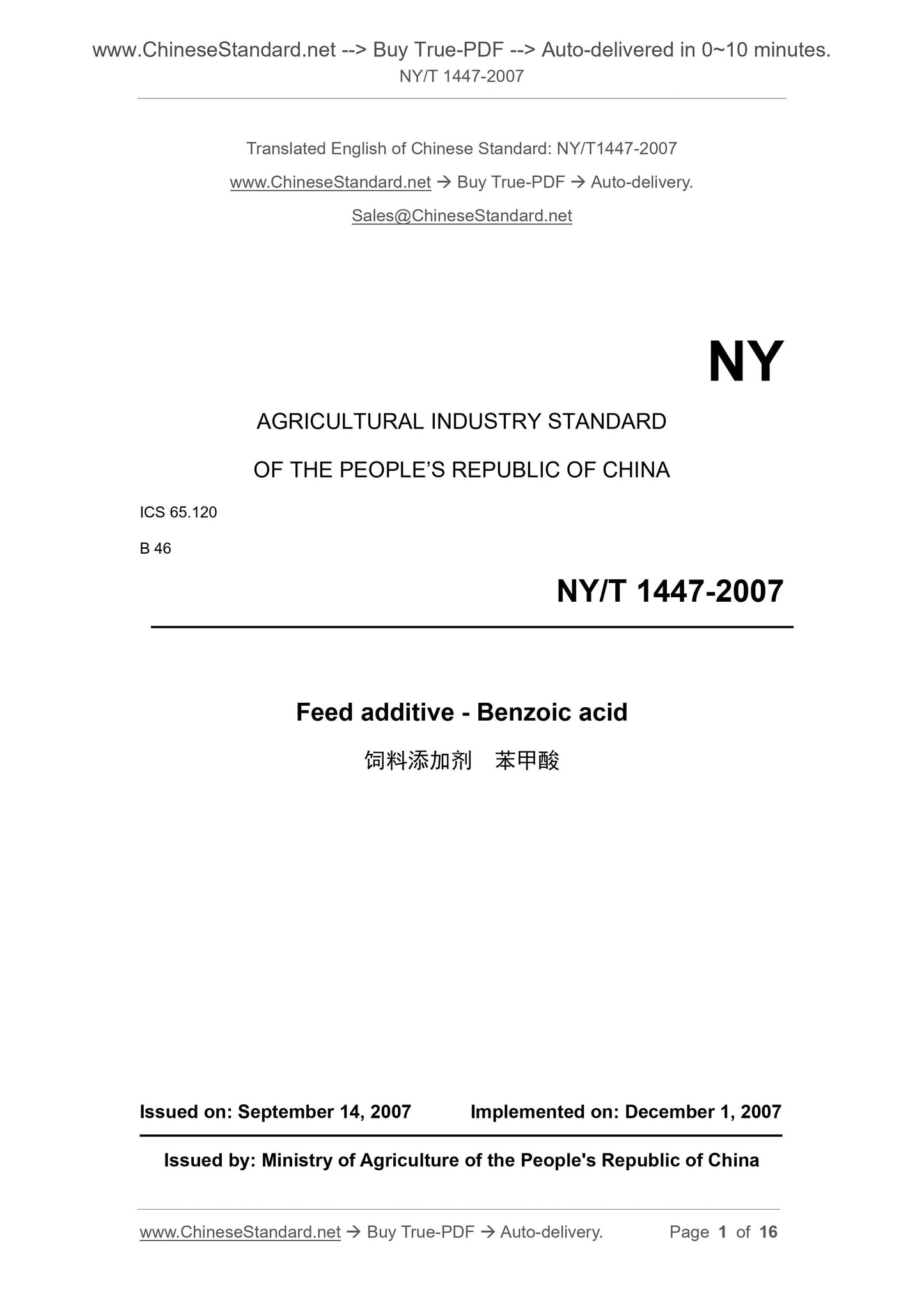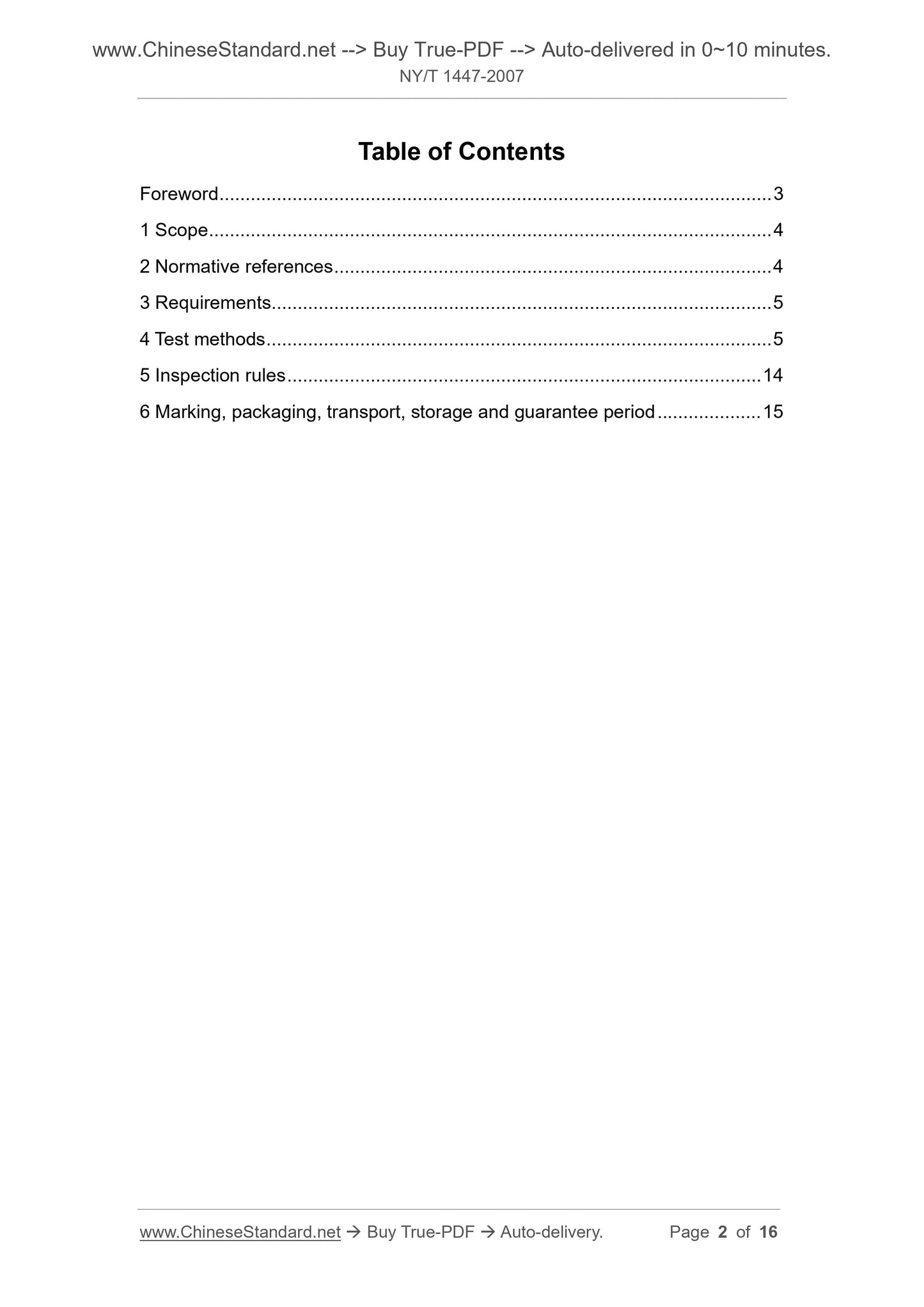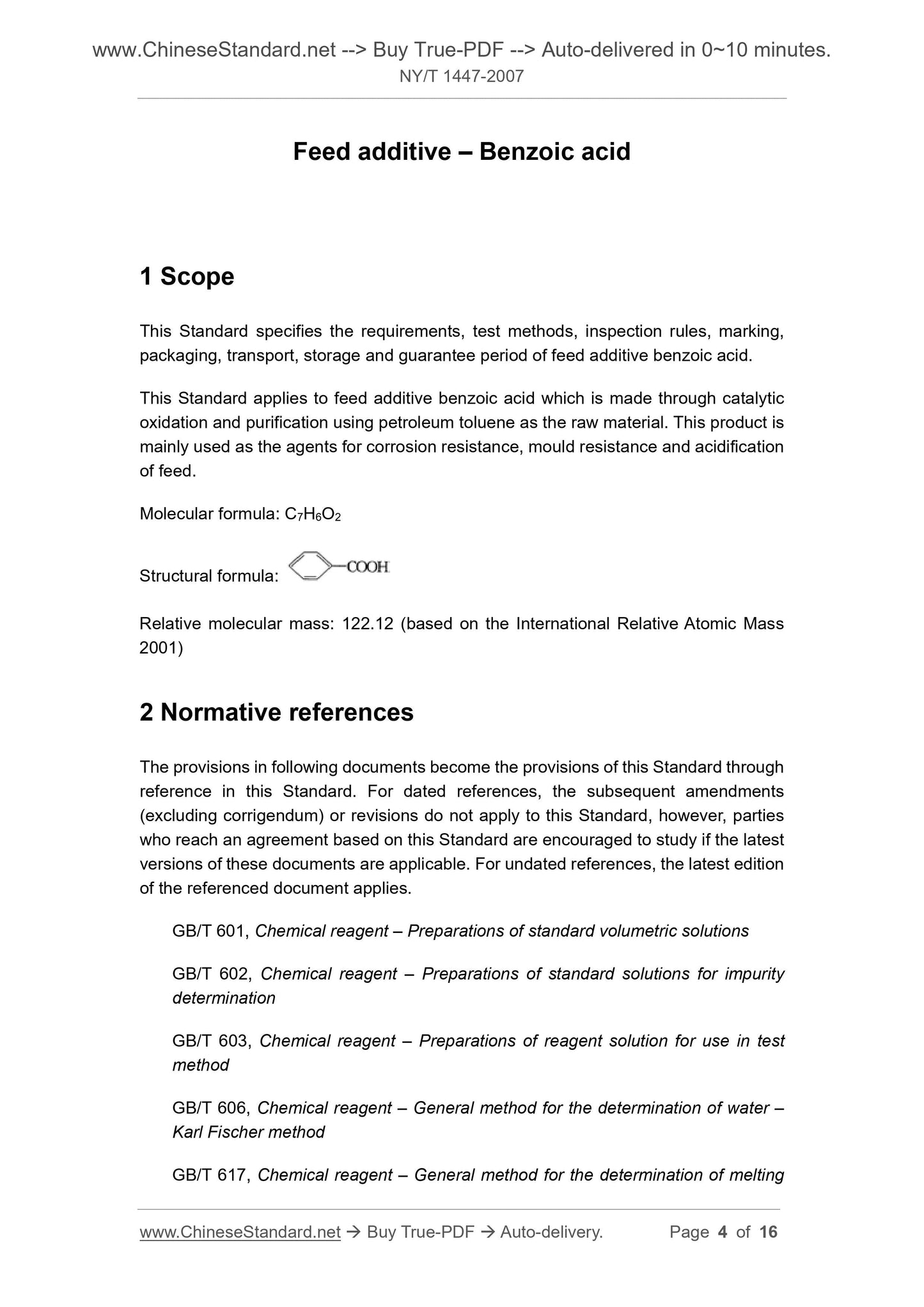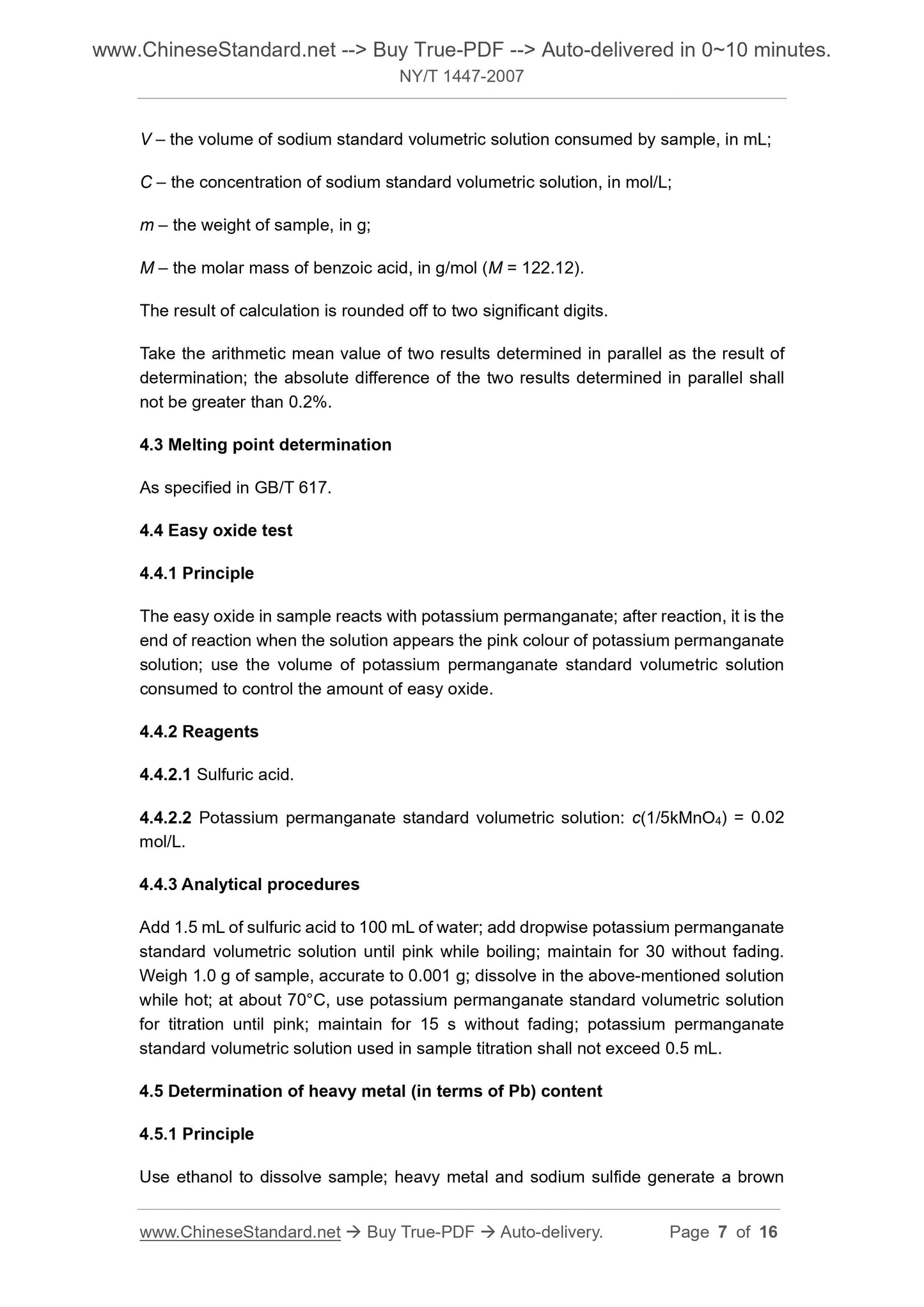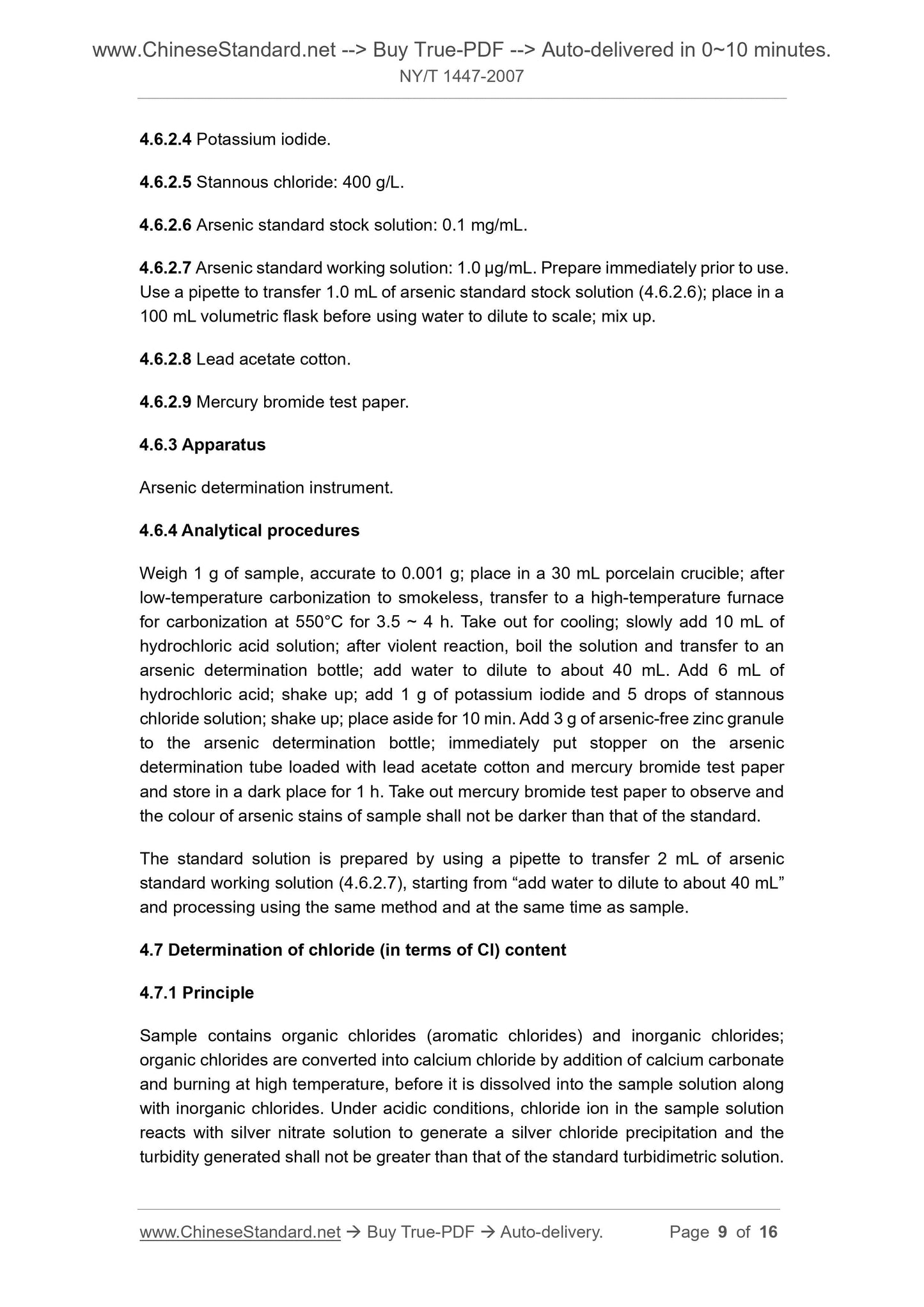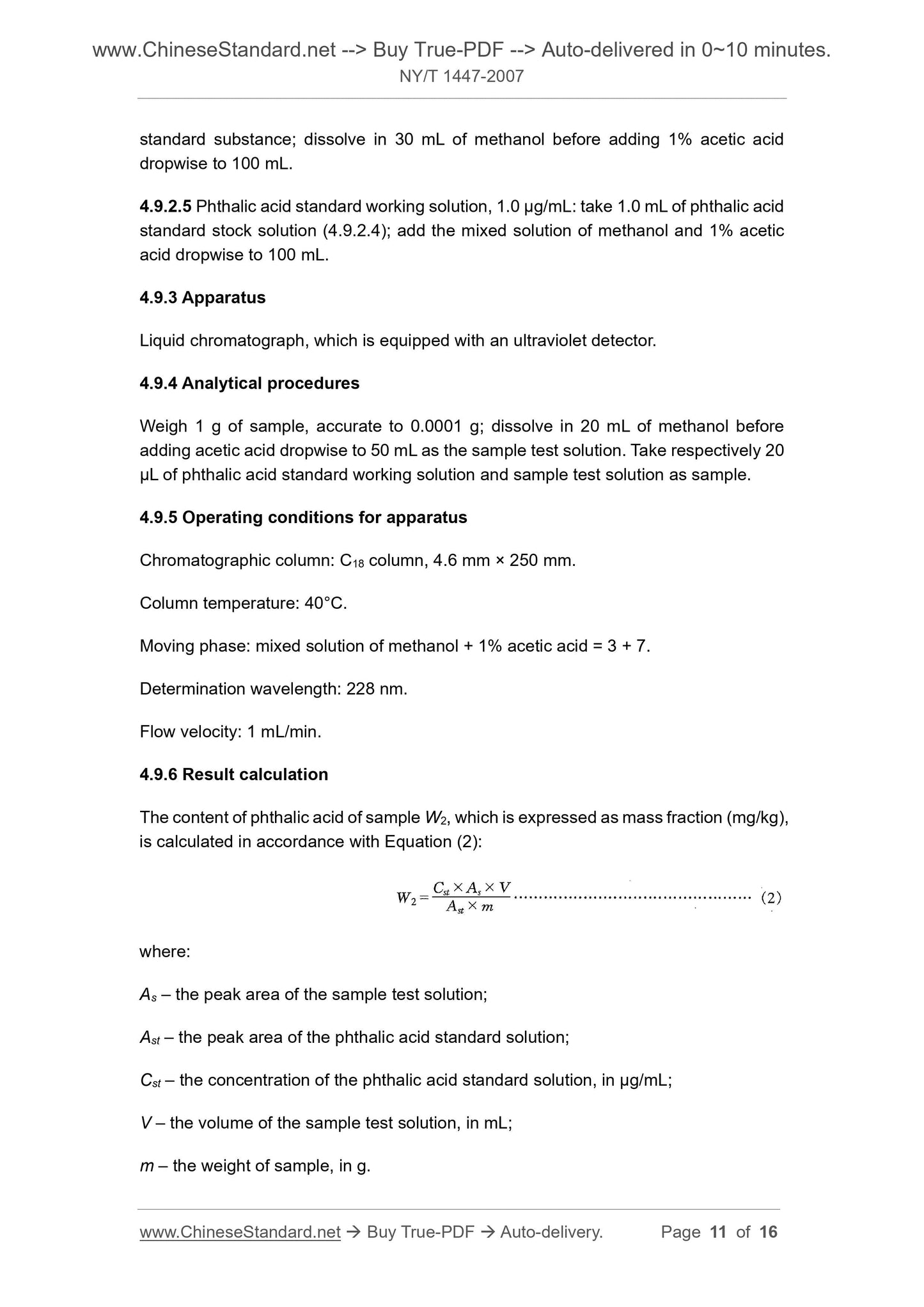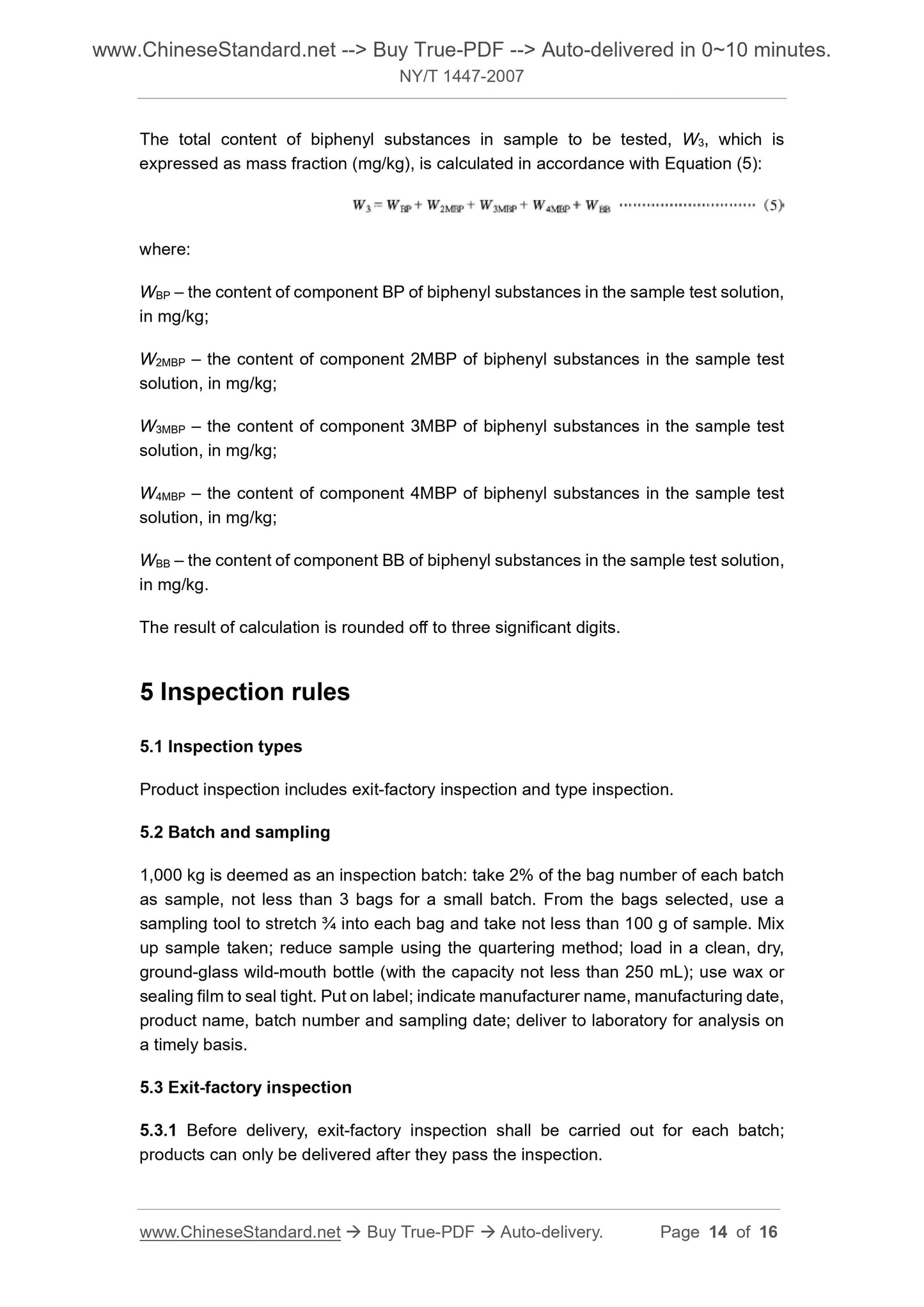1
/
of
7
PayPal, credit cards. Download editable-PDF and invoice in 1 second!
NY/T 1447-2007 English PDF (NY/T1447-2007)
NY/T 1447-2007 English PDF (NY/T1447-2007)
Regular price
$150.00 USD
Regular price
Sale price
$150.00 USD
Unit price
/
per
Shipping calculated at checkout.
Couldn't load pickup availability
Delivery: 3 seconds. Download true-PDF + Invoice.
Get QUOTATION in 1-minute: Click NY/T 1447-2007
Historical versions: NY/T 1447-2007
Preview True-PDF (Reload/Scroll if blank)
NY/T 1447-2007: Feed additive Benzoic acid
NY/T 1447-2007
NY
AGRICULTURAL INDUSTRY STANDARD
OF THE PEOPLE’S REPUBLIC OF CHINA
ICS 65.120
B 46
Feed additive - Benzoic acid
饲料添加剂 苯甲酸
ISSUED ON. SEPTEMBER 14, 2007
IMPLEMENTED ON. DECEMBER 1, 2007
Issued by. Ministry of Agriculture of the People's Republic of China
Table of Contents
Foreword ... 3
1 Scope ... 4
2 Normative references ... 4
3 Requirements... 5
4 Test methods ... 5
5 Inspection rules ... 14
6 Marking, packaging, transport, storage and guarantee period ... 15
Feed additive – Benzoic acid
1 Scope
This Standard specifies the requirements, test methods, inspection rules, marking,
packaging, transport, storage and guarantee period of feed additive benzoic acid.
This Standard applies to feed additive benzoic acid which is made through catalytic
oxidation and purification using petroleum toluene as the raw material. This product is
mainly used as the agents for corrosion resistance, mould resistance and acidification
of feed.
Molecular formula. C7H6O2
Structural formula.
Relative molecular mass. 122.12 (based on the International Relative Atomic Mass
2001)
2 Normative references
The provisions in following documents become the provisions of this Standard through
reference in this Standard. For dated references, the subsequent amendments
(excluding corrigendum) or revisions do not apply to this Standard, however, parties
who reach an agreement based on this Standard are encouraged to study if the latest
versions of these documents are applicable. For undated references, the latest edition
of the referenced document applies.
GB/T 601, Chemical reagent – Preparations of standard volumetric solutions
GB/T 602, Chemical reagent – Preparations of standard solutions for impurity
determination
GB/T 603, Chemical reagent – Preparations of reagent solution for use in test
method
GB/T 606, Chemical reagent – General method for the determination of water –
Karl Fischer method
GB/T 617, Chemical reagent – General method for the determination of melting
V – the volume of sodium standard volumetric solution consumed by sample, in mL;
C – the concentration of sodium standard volumetric solution, in mol/L;
m – the weight of sample, in g;
M – the molar mass of benzoic acid, in g/mol (M = 122.12).
The result of calculation is rounded off to two significant digits.
Take the arithmetic mean value of two results determined in parallel as the result of
determination; the absolute difference of the two results determined in parallel shall
not be greater than 0.2%.
4.3 Melting point determination
As specified in GB/T 617.
4.4 Easy oxide test
4.4.1 Principle
The easy oxide in sample reacts with potassium permanganate; after reaction, it is the
end of reaction when the solution appears the pink colour of potassium permanganate
solution; use the volume of potassium permanganate standard volumetric solution
consumed to control the amount of easy oxide.
4.4.2 Reagents
4.4.2.1 Sulfuric acid.
4.4.2.2 Potassium permanganate standard volumetric solution. c(1/5kMnO4) = 0.02
mol/L.
4.4.3 Analytical procedures
Add 1.5 mL of sulfuric acid to 100 mL of water; add dropwise potassium permanganate
standard volumetric solution until pink while boiling; maintain for 30 without fading.
Weigh 1.0 g of sample, accurate to 0.001 g; dissolve in the above-mentioned solution
while hot; at about 70°C, use potassium permanganate standard volumetric solution
for titration until pink; maintain for 15 s without fading; potassium permanganate
standard volumetric solution used in sample titration shall not exceed 0.5 mL.
4.5 Determination of heavy metal (in terms of Pb) content
4.5.1 Principle
Use ethanol to dissolve sample; heavy metal and sodium sulfide generate a brown
4.6.2.4 Potassium iodide.
4.6.2.5 Stannous chloride. 400 g/L.
4.6.2.6 Arsenic standard stock solution. 0.1 mg/mL.
4.6.2.7 Arsenic standard working solution. 1.0 μg/mL. Prepare immediately prior to use.
Use a pipette to transfer 1.0 mL of arsenic standard stock solution (4.6.2.6); place in a
100 mL volumetric flask before using water to dilute to scale; mix up.
4.6.2.8 Lead acetate cotton.
4.6.2.9 Mercury bromide test paper.
4.6.3 Apparatus
Arsenic determination instrument.
4.6.4 Analytical procedures
Weigh 1 g of sample, accurate to 0.001 g; place in a 30 mL porcelain crucible; after
low-temperature carbonization to smokeless, transfer to a high-temperature furnace
for carbonization at 550°C for 3.5 ~ 4 h. Take out for cooling; slowly add 10 mL of
hydrochloric acid solution; after violent reaction, boil the solution and transfer to an
arsenic determination bottle; add water to dilute to about 40 mL. Add 6 mL of
hydrochloric acid; shake up; add 1 g of potassium iodide and 5 drops of stannous
chloride solution; shake up; place aside for 10 min. Add 3 g of arsenic-free zinc granule
to the arsenic determination bottle; immediately put stopper on the arsenic
determination tube loaded with lead acetate cotton and mercury bromide test paper
and store in a dark place for 1 h. Take out mercury bromide test paper to observe and
the colour of arsenic stains of sample shall not be darker than that of the standard.
The standard solution is prepared by using a pipette to transfer 2 mL of arsenic
standard working solution (4.6.2.7), starting from “add water to dilute to about 40 mL”
and processing using the same method and at the same time as sample.
4.7 Determination of chloride (in terms of Cl) content
4.7.1 Principle
Sample contains organic chlorides (aromatic chlorides) and inorganic chlorides;
organic chlorides are converted into calcium chloride by addition of calcium carbonate
and burning at high temperature, before it is dissolved into the sample solution along
with inorganic chlorides. Under acidic conditions, chloride ion in the sample solution
reacts with silver nitrate solution to generate a silver chloride precipitation and the
turbidity generated shall not be greater than that of the standard turbidimetric solution.
standard substance; dissolve in 30 mL of methanol before adding 1% acetic acid
dropwise to 100 mL.
4.9.2.5 Phthalic acid standard working solution, 1.0 μg/mL. take 1.0 mL of phthalic acid
standard stock solution (4.9.2.4); add the mixed solution of methanol and 1% acetic
acid dropwise to 100 mL.
4.9.3 Apparatus
Liquid chromatograph, which is equipped with an ultraviolet detector.
4.9.4 Analytical procedures
Weigh 1 g of sample, accurate to 0.0001 g; dissolve in 20 mL of methanol before
adding acetic acid dropwise to 50 mL as the sample test solution. Take respectively 20
μL of phthalic acid standard working solution and sample test solution as sample.
4.9.5 Operating conditions for apparatus
Chromatographic column. C18 column, 4.6 mm × 250 mm.
Column temperature. 40°C.
Moving phase. mixed solution of methanol + 1% acetic acid = 3 + 7.
Determination wavelength. 228 nm.
Flow velocity. 1 mL/min.
4.9.6 Result calculation
The content of phthalic acid of sample W2, which is expressed as mass fraction (mg/kg),
is calculated in accordance with Equation (2).
where.
As – the peak area of the sample test solution;
Ast – the peak area of the phthalic acid standard solution;
Cst – the concentration of the phthalic acid standard solution, in μg/mL;
V – the volume of the sample test solution, in mL;
m – the weight of sample, in g.
The total content of biphenyl substan...
Get QUOTATION in 1-minute: Click NY/T 1447-2007
Historical versions: NY/T 1447-2007
Preview True-PDF (Reload/Scroll if blank)
NY/T 1447-2007: Feed additive Benzoic acid
NY/T 1447-2007
NY
AGRICULTURAL INDUSTRY STANDARD
OF THE PEOPLE’S REPUBLIC OF CHINA
ICS 65.120
B 46
Feed additive - Benzoic acid
饲料添加剂 苯甲酸
ISSUED ON. SEPTEMBER 14, 2007
IMPLEMENTED ON. DECEMBER 1, 2007
Issued by. Ministry of Agriculture of the People's Republic of China
Table of Contents
Foreword ... 3
1 Scope ... 4
2 Normative references ... 4
3 Requirements... 5
4 Test methods ... 5
5 Inspection rules ... 14
6 Marking, packaging, transport, storage and guarantee period ... 15
Feed additive – Benzoic acid
1 Scope
This Standard specifies the requirements, test methods, inspection rules, marking,
packaging, transport, storage and guarantee period of feed additive benzoic acid.
This Standard applies to feed additive benzoic acid which is made through catalytic
oxidation and purification using petroleum toluene as the raw material. This product is
mainly used as the agents for corrosion resistance, mould resistance and acidification
of feed.
Molecular formula. C7H6O2
Structural formula.
Relative molecular mass. 122.12 (based on the International Relative Atomic Mass
2001)
2 Normative references
The provisions in following documents become the provisions of this Standard through
reference in this Standard. For dated references, the subsequent amendments
(excluding corrigendum) or revisions do not apply to this Standard, however, parties
who reach an agreement based on this Standard are encouraged to study if the latest
versions of these documents are applicable. For undated references, the latest edition
of the referenced document applies.
GB/T 601, Chemical reagent – Preparations of standard volumetric solutions
GB/T 602, Chemical reagent – Preparations of standard solutions for impurity
determination
GB/T 603, Chemical reagent – Preparations of reagent solution for use in test
method
GB/T 606, Chemical reagent – General method for the determination of water –
Karl Fischer method
GB/T 617, Chemical reagent – General method for the determination of melting
V – the volume of sodium standard volumetric solution consumed by sample, in mL;
C – the concentration of sodium standard volumetric solution, in mol/L;
m – the weight of sample, in g;
M – the molar mass of benzoic acid, in g/mol (M = 122.12).
The result of calculation is rounded off to two significant digits.
Take the arithmetic mean value of two results determined in parallel as the result of
determination; the absolute difference of the two results determined in parallel shall
not be greater than 0.2%.
4.3 Melting point determination
As specified in GB/T 617.
4.4 Easy oxide test
4.4.1 Principle
The easy oxide in sample reacts with potassium permanganate; after reaction, it is the
end of reaction when the solution appears the pink colour of potassium permanganate
solution; use the volume of potassium permanganate standard volumetric solution
consumed to control the amount of easy oxide.
4.4.2 Reagents
4.4.2.1 Sulfuric acid.
4.4.2.2 Potassium permanganate standard volumetric solution. c(1/5kMnO4) = 0.02
mol/L.
4.4.3 Analytical procedures
Add 1.5 mL of sulfuric acid to 100 mL of water; add dropwise potassium permanganate
standard volumetric solution until pink while boiling; maintain for 30 without fading.
Weigh 1.0 g of sample, accurate to 0.001 g; dissolve in the above-mentioned solution
while hot; at about 70°C, use potassium permanganate standard volumetric solution
for titration until pink; maintain for 15 s without fading; potassium permanganate
standard volumetric solution used in sample titration shall not exceed 0.5 mL.
4.5 Determination of heavy metal (in terms of Pb) content
4.5.1 Principle
Use ethanol to dissolve sample; heavy metal and sodium sulfide generate a brown
4.6.2.4 Potassium iodide.
4.6.2.5 Stannous chloride. 400 g/L.
4.6.2.6 Arsenic standard stock solution. 0.1 mg/mL.
4.6.2.7 Arsenic standard working solution. 1.0 μg/mL. Prepare immediately prior to use.
Use a pipette to transfer 1.0 mL of arsenic standard stock solution (4.6.2.6); place in a
100 mL volumetric flask before using water to dilute to scale; mix up.
4.6.2.8 Lead acetate cotton.
4.6.2.9 Mercury bromide test paper.
4.6.3 Apparatus
Arsenic determination instrument.
4.6.4 Analytical procedures
Weigh 1 g of sample, accurate to 0.001 g; place in a 30 mL porcelain crucible; after
low-temperature carbonization to smokeless, transfer to a high-temperature furnace
for carbonization at 550°C for 3.5 ~ 4 h. Take out for cooling; slowly add 10 mL of
hydrochloric acid solution; after violent reaction, boil the solution and transfer to an
arsenic determination bottle; add water to dilute to about 40 mL. Add 6 mL of
hydrochloric acid; shake up; add 1 g of potassium iodide and 5 drops of stannous
chloride solution; shake up; place aside for 10 min. Add 3 g of arsenic-free zinc granule
to the arsenic determination bottle; immediately put stopper on the arsenic
determination tube loaded with lead acetate cotton and mercury bromide test paper
and store in a dark place for 1 h. Take out mercury bromide test paper to observe and
the colour of arsenic stains of sample shall not be darker than that of the standard.
The standard solution is prepared by using a pipette to transfer 2 mL of arsenic
standard working solution (4.6.2.7), starting from “add water to dilute to about 40 mL”
and processing using the same method and at the same time as sample.
4.7 Determination of chloride (in terms of Cl) content
4.7.1 Principle
Sample contains organic chlorides (aromatic chlorides) and inorganic chlorides;
organic chlorides are converted into calcium chloride by addition of calcium carbonate
and burning at high temperature, before it is dissolved into the sample solution along
with inorganic chlorides. Under acidic conditions, chloride ion in the sample solution
reacts with silver nitrate solution to generate a silver chloride precipitation and the
turbidity generated shall not be greater than that of the standard turbidimetric solution.
standard substance; dissolve in 30 mL of methanol before adding 1% acetic acid
dropwise to 100 mL.
4.9.2.5 Phthalic acid standard working solution, 1.0 μg/mL. take 1.0 mL of phthalic acid
standard stock solution (4.9.2.4); add the mixed solution of methanol and 1% acetic
acid dropwise to 100 mL.
4.9.3 Apparatus
Liquid chromatograph, which is equipped with an ultraviolet detector.
4.9.4 Analytical procedures
Weigh 1 g of sample, accurate to 0.0001 g; dissolve in 20 mL of methanol before
adding acetic acid dropwise to 50 mL as the sample test solution. Take respectively 20
μL of phthalic acid standard working solution and sample test solution as sample.
4.9.5 Operating conditions for apparatus
Chromatographic column. C18 column, 4.6 mm × 250 mm.
Column temperature. 40°C.
Moving phase. mixed solution of methanol + 1% acetic acid = 3 + 7.
Determination wavelength. 228 nm.
Flow velocity. 1 mL/min.
4.9.6 Result calculation
The content of phthalic acid of sample W2, which is expressed as mass fraction (mg/kg),
is calculated in accordance with Equation (2).
where.
As – the peak area of the sample test solution;
Ast – the peak area of the phthalic acid standard solution;
Cst – the concentration of the phthalic acid standard solution, in μg/mL;
V – the volume of the sample test solution, in mL;
m – the weight of sample, in g.
The total content of biphenyl substan...
Share
